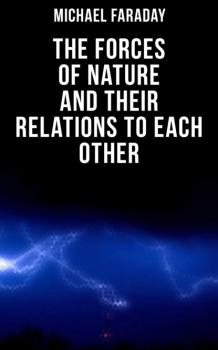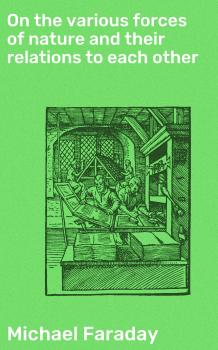Michael Faraday
Список книг автора Michael FaradayThe Forces of Matter
"The Forces of Matter" by Michael Faraday. Published by Good Press. Good Press publishes a wide range of titles that encompasses every genre. From well-known classics & literary fiction and non-fiction to forgotten−or yet undiscovered gems−of world literature, we issue the books that need to be read. Each Good Press edition has been meticulously edited and formatted to boost readability for all e-readers and devices. Our goal is to produce eBooks that are user-friendly and accessible to everyone in a high-quality digital format.
The Forces of Nature and their Relations to Each Other
Which was first, Matter or Force? If we think on this question, we shall find that we are unable to conceive of matter without force, or of force without matter. (W. Crookes in On the various forces of nature and their relations to each other) The following publication presents the collection of lectures, discourses and speculations of Professor Faraday. Contents: THE FORCE OF GRAVITATION GRAVITATION—COHESION COHESION—CHEMICAL AFFINITY CHEMICAL AFFINITY—HEAT MAGNETISM—ELECTRICITY THE CORRELATION OF THE PHYSICAL FORCES LECTURE ON LIGHT-HOUSE ILLUMINATION—THE ELECTRIC LIGHT Michael Faraday was an English scientist who contributed to the study of electromagnetism and electrochemistry. His main discoveries include the principles underlying electromagnetic induction, diamagnetism and electrolysis.
The Chemical History of a Candle (Scientific Lectures)
The Chemical History of a Candle presents a series of lectures on the chemistry and physics of flames given by Michael Faraday. The lectures described the different zones of combustion in the candle flame and the presence of carbon particles in the luminescent zone. Demonstrations included the production and examination of the properties of hydrogen, oxygen, nitrogen and carbon dioxide gases. An electrolysis cell is demonstrated, first in the electroplating of platinum conductors by dissolved copper, then the production of hydrogen and oxygen gases and their recombination to form water. The properties of water itself are studied, including its expansion while freezing (iron vessels are burst by this expansion), and the relative volume of steam produced when water is vaporized. Techniques for weighing gases on a balance are demonstrated. Atmospheric pressure is described and its effects demonstrated.
The Chemical History of a Candle
One of the greatest experimental scientists of all time, Michael Faraday (1791–1867) developed the first electric motor, electric generator, and dynamo — essentially creating the science of electrochemistry. This book, the result of six lectures he delivered to young students at London’s Royal Institution, concerns another form of energy — candlelight.Faraday titled the lectures «The Chemical History of a Candle,» choosing the subject because, as he explained, «There is not a law under which any part of this universe is governed which does not come into play and is not touched upon [during the time a candle burns].»That statement is the foundation for a book that describes, with great clarity, the components, function and weight of the atmosphere; the function of a candle wick; capillary attraction; the carbon content in oxygen and living bodies; the production of carbon dioxide from coal gas and sugar; the properties of carbonic acid; respiration and its analogy to the burning of a candle; and much more. There is also a chapter comprising Faraday's «Lecture on Platinum.»A useful classroom teaching tool, this classic text will also appeal to a wide audience interested in scientific inquiry.





